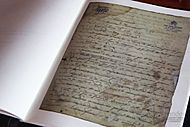Jamaica Letter facts for kids
Quick facts for kids {{{document_name}}} |
|
 |
|
| Created | September 6, 1815 |
| Authors | Simón Bolívar |
The Jamaica Letter (also known as Carta de Jamaica) is a famous document written by Simón Bolívar in Jamaica in 1815. It was a reply to a letter from Henry Cullen, a merchant from Jamaica. In this important letter, Bolívar shared his ideas about the situation in Spanish America. He talked about the power of the Spanish Empire and what might happen to the new countries that would form after the empire fell apart.
Contents
Bolívar's Journey and Challenges
This section will explain what led Bolívar to write the Jamaica Letter.
The End of Venezuela's Second Republic
In 1813, Simón Bolívar quickly led a campaign called the Admirable Campaign. This allowed him to take back Caracas on August 6, 1813. However, this success did not last long. In 1814, the royalist troops, led by José Tomás Boves, defeated Bolívar's forces.
This defeat forced Bolívar to leave Venezuela. He had lost much of his authority, and some of his own officers disagreed with him. The Second Republic of Venezuela then came to an end.
Return to New Granada
After leaving Venezuela, Bolívar went to Cart on September 8, 1814. He stayed in New Granada from October 1814 to April 1815. This time, Bolívar did not have the same success he had in 1813.
He was working under the authorities of New Granada. They asked him to fight against other patriot groups instead of the Spanish loyalist armies. Bolívar could not handle the civil war between these patriot groups. He also did not have much political power or support from many people in New Granada. Because of these difficulties, Bolívar decided to step down from his military role and leave Spanish America.
Bolívar's Time in Jamaica
Bolívar traveled to Jamaica on May 8, 1815, arriving six days later. He hoped to get the attention of the British Empire. He believed that if Britain helped Latin America gain independence, it would also benefit Britain economically.
Bolívar tried to convince British gentlemen of his plans. For example, he suggested giving Britain control of Panama and Nicaragua. He thought this would help them build waterways, like the future Panama Canal and the Nicaragua Canal.
Bolívar lived in Kingston, Jamaica, from May to December 1815. He did not take part in military actions during this time. Instead, he spent his time thinking deeply about the future of the American continent. He considered the global political situation while doing so.
In 1815, Bolívar had gained some sympathy from the British. However, he was very poor, with few belongings and little money. His economic situation became very bad by October.
Before these difficult times in October 1815, Bolívar had already written the Carta de Jamaica. Months later, his friends from New Granada asked him to help them fight against Spanish troops led by Pablo Morillo. But it was too late. Morillo's forces had already taken the city of Cartagena. This event made Bolívar change his plans. He decided to go to Haiti to get help from Alexandre Pétion. Bolívar left Jamaica on December 24.
The Carta de Jamaica
What the Letter Was About
The Carta de Jamaica was completed on September 7, 1815, in Kingston. In this letter, Bolívar first looked back at the successes of the fight for freedom in the Americas up to that point. He reviewed the strength the patriots had gained between 1810 and 1815.
In the middle part of the document, Bolívar explained why the "Spanish Americans" were right to seek independence. He then asked Europe to help free the Latin American peoples. In the final part, he thought about and discussed the future of different regions. These included Mexico, Central America, New Granada, Venezuela, Río de la Plata, Chile, and Peru.
Finally, Bolívar ended his thoughts with a strong belief he would hold until his death. This was the need for the union of the countries of the Americas. Even though the Carta de Jamaica was addressed to Henry Cullen, its main goal was clear. Bolívar wanted to get the attention of Britain, the most powerful liberal nation of the 19th century. He hoped Britain would decide to get involved in American independence. However, when Britain finally responded, Bolívar had already chosen to accept help from Haiti instead.
See also
 In Spanish: Carta de Jamaica para niños
In Spanish: Carta de Jamaica para niños

